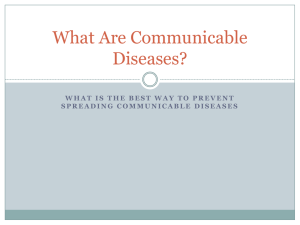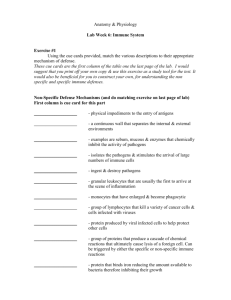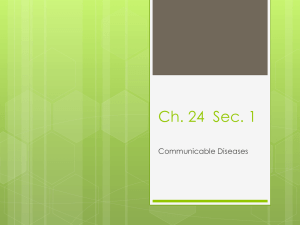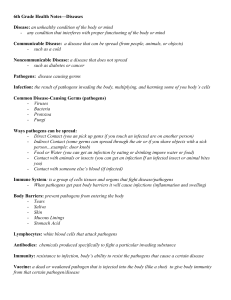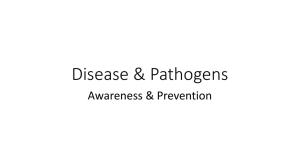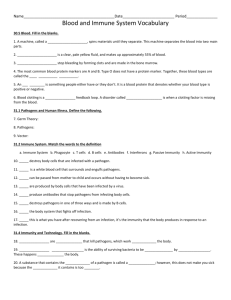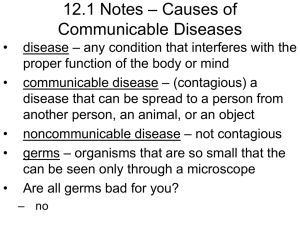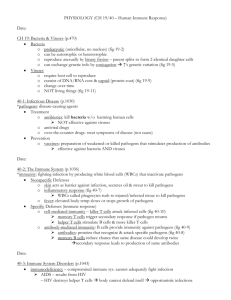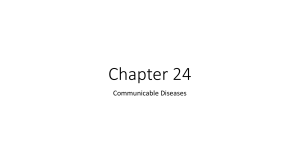Disease Prevention
advertisement
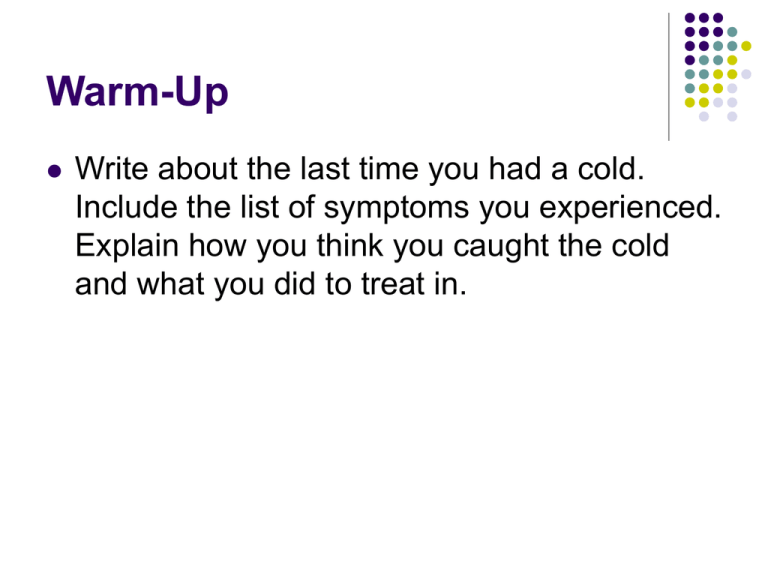
Warm-Up Write about the last time you had a cold. Include the list of symptoms you experienced. Explain how you think you caught the cold and what you did to treat in. Communicable Disease Prevention Lesson 31 Objectives Examine the effects of health behaviors on skin Examine the relationship between health behaviors and the ways that communicable diseases are spread Develop and analyze strategies related to the prevention of communicable and non-communicable diseases Identify available health related services in the community that provide vaccines and information related to disease prevention Identify the causes, transmission, symptoms and treatment of several communicable diseases Discuss how public health policies and government regulations influence health promotion and disease prevention Communicable Diseases Disease that is spread from one living thing to another or through the environment Causes: Pathogen: organism that causes disease Viruses Bacteria Fungi Protozoans Rickettsias Infection: condition that occurs when pathogens enter the body, multiply and damage body cell Viruses Pieces of genetic material surrounded by a protein coat Need living cells to reproduce Invade all known forms of life After the virus penetrates a it takes control of the cell to manufacture more viruses Antibiotics do not work against viruses Bacteria Single celled microorganisms Live almost everywhere on earth Most are harmless Multiply through cell division in the body Some produce a toxin Substance that kills cells or interferes with their functions Can be treated with antibiotics Other Types of Pathogens Fungi Plantlike organisms Molds Yeasts Some can cause diseases of the skin, mucous membranes or the lungs Protozoans Single-celled organisms that are larger and more complex than bacteria Rickettsias Pathogens that resemble bacteria Multiply by invading the cells of another life form Often enter humans through the bites of insects, such as fleas or lice Figure 24.1 Pg 623 Diseases by Type of Pathogen How Communicable Diseases are Transmitted Direct Contact: spread by contact with an infected person, animal, or something in the environment Touching Biting Kissing Sexual contact Sneezing Coughing Indirect Contact: spread indirectly, without being close to an infected person Contaminated objects: objects that have infectious discharges or secretions, such as a table that someone ahs sneezed on Vectors: organism, usually an arthropod, such as a tick, that carries and transmits pathogens to humans or other animals common vectors include flies, mosquitoes and ticks Water and Food Airborne Transmission Pathogens from a sneeze or cough may float in the air for a long time over long distances Chicken pox, tuberculosis, influenza and anthrax can be spread this way Preventing Communicable Diseases Physical and chemical barriers make up your body’s first line of defense Figure 24.1 Pg 628 Skin Epidermis: outer, thinner layer of skin that is composed of living and dead cells Dermis: thicker layer of skin beneath the epidermis made up of connective tissue and containing blood vessels and nerves The skin is the first line of defense against many pathogens, however it can be compromised by various actions Exposure to sun Body piercing tattooing Protecting Your Skin Always wear sunscreen on exposed areas Use a SPF that is 15 or higher Use a sunscreen that protects against both UVA and UVB rays Apply 15 to 30 minutes before going outside Use even on cloudy days and when participating in winter sports Body Piercing and Tattooing Result in the physical barrier of the skin being broken Possibility of bacteria or viruses entering the body increases Transfer of blood borne pathogens through the use of nonsterile needles Hepatitis B Hepatitis C HIV If considering getting a piercing or a tattoo consider long term consequences. Make sure you go to a reputable and clean place to decrease chances of disease or infection Remember, your skin protects you, so harming your skin can harm your entire body… The Immune System Network of cells, tissues, organs and chemicals that fights off pathogens 2 major defense strategies Inflammatory response: reaction to tissue damage caused by injury or infection (general response) Specific defenses: work against particular pathogens Inflammatory Response In response to invasion by microorganisms and to tissue damage Blood vessels near the site expand, allowing more blood flow to the area Fluid and cells from the bloodstream leak into the area Collection of fluid and white blood cells causes swelling and pain because of pressure on nerve endings Phagocyte: white blood cell that attacks invading pathogens Phagocytes engulf pathogens and then destroy them with chemicals Pus may collect at the site Collection of dead white blood cells and damaged tissues Specific defenses are activated in an effort to prevent this same infection from occurring again Specific Defenses React to invasion as a result of the body’s ability to recognize certain pathogens and destroy them Antigen: substance that is capable of triggering an immune response During the immune response certain types of white blood cells react to these antigens Lymphocytes Specialized white blood cell that coordinates and performs many of the functions of specific immunity T Cells Helper T Cells Killer T Cells Attack and destroy infected body cells Don’t attack the pathogen, only the infected cells Suppressor T Cells Trigger the production of B cells and killer T cells Coordinate the activities of other T cells “turn off” helper T cells when infection has been cleared B Cells Produce antibodies Proteins that act against specific antigens Attach to foreign antigens to mark them for destruction Destroy invading pathogens Block viruses from entering body cells Memory Lymphocytes Some T cells and B cells that have been activated by antigens become memory cells Recognize a former invader Attack viruses immediately, protecting you from becoming ill Active Immunity Immunity your body develops to protect you from diseases Naturally acquired when your body is exposed to antigens from invading pathogens Artificially acquired immunity develops in response to a vaccine Some immunities last a lifetime, but others need to be repeated to maintain immunity Passive Immunity Receiving antibodies from another person or animal Short lived immunity, lasting only weeks to months Natural passive immunity occurs when antibodies pass from mother to child during pregnancy or while nursing Artificial passive immunity results fro the injection of antibodies produce by an animal or a human who is immune to the disease Lymphatic System: Figure 24.4 pg 632 Care of the Immune System Eat healthy, making sure to consume nutrient rich foods Get plenty of rest Get about an hour of physical activity every day Avoid sharing personal items Towels, toothbrushes, make up Avoid tobacco, alcohol and other drugs Avoid sexual contact Fatigue reduces the effectiveness of the immune system Some STDs, such as HIVE actually destroy the immune system Keep immunizations up to date Vaccines to Aid the Body’s Defenses Live-Virus Vaccines Killer-Virus Vaccines Use inactivated pathogens Even though they are dead, the organism still stimulate as immune response, producing antibodies Vaccines for the flu, polio, hepatitis A, rabies, cholera and the plague are produced in this way Toxoids Made from pathogens grown under special laboratory condition to make them lose most of their disease causing properties The weakened virus can still stimulate the production of antibodies Vaccines for measles, mumps, rubella and chick pox are produced in this way Inactivated toxins from pathogens Used to stimulate the production of antibodies Many pathogens aren’t harmful themselves, but the toxins they produce are Tetanus and diptheria immunizations work in this way New and second generation vaccines Being developed by scientist using new technologies Vaccine for hepatitis B is made from genetically altered yeast cells Common Communicable Diseases Respiratory Infections Can occur anywhere from the nose to the alveoli of the lungs Most caused by viruses or bacteria Common respiratory infections include: Common cold Influenza Pneumonia Strep throat tuberculosis The Common Cold Viral infection Causes inflammation of the mucous membranes that line the nose and throat Symptoms: Runny nose Sneezing Sore throat No cure Treatments may help to relieve symptoms, and most cold will clear up in a week or so Influenza The flu Viral infection of the respiratory tract Most often spread through airborne transmission Symptoms: High fever Fatigue Headache Muscle aches Cough Antiviral drugs for treatment are available, but need to be given as soon as the illness arises Flu vaccination is available in a shot or nasal mist The Flu can lead to pneumona Pneumonia An infection of the lungs in which the air sacs fill with pus and other liquid One of the top 10 causes of death in the US along with the flu Viral pneumonia is relatively short-lived and produces symptoms similar to those of the flu Bacterial pneumonia can be treated with antibiotics Bacteria that cause pneumonia are often present in healthy throats, but when the body defenses are weakened they may get into the lungs and multiply Strep Throat Bacterial infection spread by direct contact Symptoms Sore throat Fever Enlarged lymph nodes Untreated strep throat can lead to serious complications, including inflammation of the kidneys and rheumatic fever, which can cause permanent heart damage Treated with anitbiotics Tuberculosis “TB” Bacterial disease that usually attacks the lungs Spread through the air when a person with the disease coughs or sneezes Most people who are infected carry the bacteria in their lungs but never develop the disease Some strains have developed resistance to antibiotics Hepatitis A Another one of the top 10 communicable diseases report in the US Most commonly spread through contact with feces of an infected person Symptoms B More serious than hepatitis A Found in bodily fluids of an infected person Often transmitted through sexual contact Most people never experience symptoms, however, serious symptoms can occur Fever Nausea Vomiting Fatigue Abdominal pain Jaundice: yellowing of the skin and eyes Severe liver damage including liver failure and cirrhosis (scarring) of the liver May be responsible for up to 80% of all cases of liver cancer worldwide C Most common chronic blood-borne infection in the US Transmitted by direct contact with infected blood Can lead to chronic liver disease, liver cancer and liver failure Leading reason for liver transplants in the US No cure Other Common Communicable Diseases: Figure 24.5 pg 640 Emerging Infections Communicable disease whose incidence in humans has increased within the past two decades or threatens to increase in the near future Factors contributing to the development of emerging infections include: Transport across borders Infected people and animals carry pathogens from regions to region Population movement Resistance to antibiotics Changes in food technology Agents of bioterrorism Because of the ease and frequency of travel, a contagious bioterrorist agent can spread rapidly from country to country Strategies for Preventing Communicable Disease Wash Hands Handle Food Properly Eat a balanced diet Avoid sharing utensils Avoid unnecessary contact with people who are ill Take care of yourself when you are ill Get vaccinated against particular disease as recommenced by your physician Abstain from sexual activity Learn to manage stress
